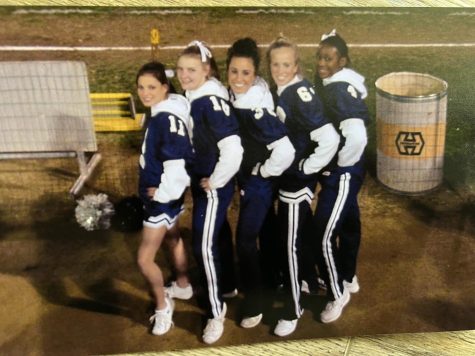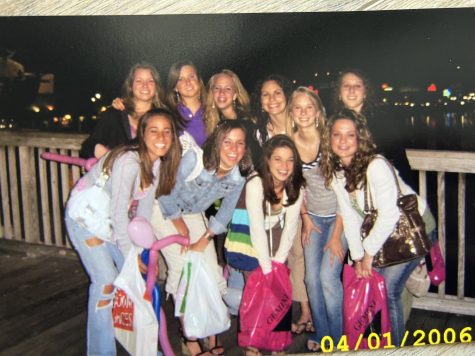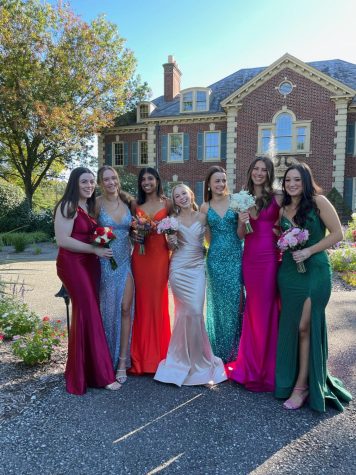Day in the Life of a Dallastown Student- Part 3
A four-part series of how students’ days at Dallastown differ from each decade.
Photos submitted; Graphic by Delaney Fisher
This series takes a look at four girls while they were high school students at Dallastown in four different decades.
This is the third part in a four-part series examining the life of students at Dallastown through the decades. Use the link below to read the first article.
Introduction:
The more things change, the more they stay the same. From dress codes and school lunches to classroom technology and cars in the parking lot, so much has changed at Dallastown High School over the years.
In fact one might think that a student from the 1960s has nothing in common with a high schooler today.
To discover what has changed and what has stayed the same, three former and one current DHS students were interviewed to compare a day in the life of a Dallastown student over the decades.
Meet the students:
Debra Raver attended DHS in the 1960’s. After college, she taught English at Dallastown for 26 years, and is now retired.
Lisa Fisher attended DHS in the 1980s. She was actively involved in the Dallastown community before moving to South Carolina with her family.
Toni Sprenkle attended DHS in the early 2000s. She is currently the Varsity Football, Wrestling, and Competition cheer coach.
Kayla Sebastian is currently a senior at DHS. She is the Student Body Vice President in addition to being a student-athlete involved with various other clubs and organizations.
Class is dismissed, but the day isn’t over for our Wildcats! From after-school activities and jobs to practices and games, the students are busy after the final bell has rung.
Activities & Clubs
One thing that clearly hasn’t changed over the years is that the students of DHS are actively involved in their school.
While there are many newer clubs and activities offered at Dallastown today including Mini-THON, fashion club, and health STAT club, many other clubs have been around for decades!
Both Raver and Sprenkle were editors of the Spectator yearbook and staff members of the Beacon. Raver was a writer for the Beacon, while Sprenkle was an editor. Both the Spectator and Beacon are still published today.
Representing your classmates and making the school a better place has always been a priority. Raver, Sprenkle, and Sebastian were all members of the student council. Sprenkle and Sebastian were even both voted student council president!
Fisher and Raver enjoyed showcasing their musical talents. Fisher was an active member of the band, and Raver was a part of the concert choir and the musicals.
Each student also participated in activities unique to their own personal interests.
Raver was a member of the drama club and games club.
Sprenkle spent lots of time in the community as a member of the Volunteer club and joined Varsity Club due to her love of sports.
Also a sports fan, Fisher enjoyed managing the baseball team in the spring.
Sports
Dallastown students have always enjoyed participating in after-school sports, but there used to be much fewer options.
Some of the most popular sports today weren’t even offered when Raver and Fisher went to school.
Girls Soccer wasn’t introduced until 1994.
Also, while students today are used to seeing female student-athletes break records and revolutionize the game, there used to be hardly any opportunities for girls in sports.
“Unfortunately, I was young when there were fewer sports for girls, just volleyball and track. Everything else was intramural and mainly for exercise and fun, nothing that built skills,” Raver remembers.
Today, there are 19 PIAA sports offered at Dallastown, with Girls Wrestling being the most recent addition.

Both Sprenkle and Sebastian represented the Wildcats as student-athletes. Sprenkle was a Varsity football, wrestling, and competition cheerleader and a member of the track and field team. Sebastian finished her final season as a member of the girl’s tennis team last fall.

After-School Jobs
Outside of campus, the Wildcats keep busy and earn some spending cash by working at after-school jobs.
“I worked at Ruby Tuesday as a hostess, until I turned 18 and started serving,” Sprenkle said. Other than working in restaurants, many of Sprenkle’s peers worked in retail.
Fisher worked at Christmas Tree Hill on the weekends. Many of her classmates chose to work in the fast-food industry.
“I have a job at Suburban Bowlerama as a Party Hostess and Snack Bar Attendant, and work 3 times a week. A lot of my friends work at pizza shops or their family’s company,” Sebastian said.
However, it was not as common in the 1960s for students to work after-school.
“I did not have a job during the school year, except babysitting. I had too much homework to work in the local grocery store or Smith Village coffee shop,” Raver said.
Homework
After a long day at school, the last thing any Wildcat wants to do is come home and do more schoolwork. But, homework has been around for a long time.
Some students spend hours studying for tests, completing assignments, and reading in preparation for the next day’s lesson. Others forget there was an even assignment until the teacher asks them to turn it in.
“I wrote many essays, memorized poems, read lots of history, civics, novels, and science, and dragged home heavy textbooks to do the work,” Raver remembers.
Today, heavy textbooks have been traded out for chromebooks. Students complete most homework assignments online through platforms like Google Classroom and WebAssign.
There’s often a debate on if student’s today receive more or less homework than their parents did. It turns out Fisher, Sprenkle, and Sebastian all recall having about 2 hours of homework each night.
“I tried to get homework done during study halls,” Sprenkle said.
In the 2000s when Sprenkle was in school, most students had about 3-5 study halls a week all school year long. Today, the built-in Wildcat period at the end of the day is often used by students to catch up on homework if they don’t have a study hall that trimester.
Spending Time With Friends
Between jobs, sports and activities, it may seem like a Wildcat’s afternoon is packed full. But, something that hasn’t changed is that teenagers always can find time to spend time with their friends.
Both Raver and Fisher enjoyed going to the movies and going shopping. Instead of hopping in their cars, Raver and her friends would ride a local bus to the city to go to the movie theater and shops. Fisher loved shopping at the York Mall.
Other activities popular in the 80s included cruising the York circuit and hanging out at Showbiz.
Sprenkle and her friends loved to spend time outside.
“We usually spent our weekends having group bonfires and going four-wheeling,” Sprenkle said.
While many adults perceive that all teenagers do today is sit on their phones, they actually hang out in similar ways that Raver and her friends did.

“Friends got together at houses with rec rooms in the basements, sometimes organizing slumber parties for girlfriends and weekend pizza parties. There were drive-in restaurants to hang out if anyone had a car,” Raver said.
“My friends and I usually go out to eat or have a sleepover if we are hanging out for an extended period of time,” Sebastian said.

Something that is more 2023 than 1963 is that Sebastian and her friends typically visit Starbucks after school for a drink and snack.
Communication
While it is fun to spend time with friends, there are some school nights where our Wildcats end up staying home. How Dallastown students communicated with their peers after-school has changed drastically over the years.
For Raver, her communication with friends was minimal.
“I wrote long letters (early texting?) to my friends who lived in Dallastown and Spry in the summers. There was no privacy to chat on the one phone we had in the house,” Raver said.
Both Raver and Fisher grew up in a time without cell phones, and had to rely on making phone calls on the house phone.
During the school day, Fisher and Sprenkle would pass notes to their friends. Most students today still pass notes – just not on paper, but rather on their phone.
Sprenkle and Sebastian used their cell phones to text their friends.
But, unlike the other student’s, Sebastian uses social media to easily communicate with her friends.
Apps like Snapchat, Instagram, TikTok, and Discord keep Wildcats connected at all hours of the day.
Conclusion
After a busy afternoon, the students are ready to head back home and enjoy their evening. But, the day is not over yet! Our Wildcats will take us through their evening routines and reflect on their high school experience.
Stay tuned for Part IV – the final installment – of this four-part story to continue to explore what a day in the life of a Dallastown student looks like through the decades!
Your donation will support the student journalists of Dallastown Area High School. Your contribution will allow us to purchase equipment and cover our annual website hosting costs.